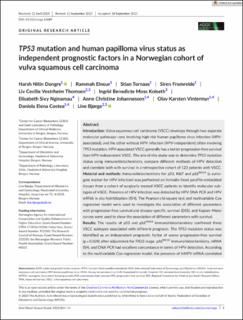| dc.contributor.author | Dongre, Harsh Nitin | |
| dc.contributor.author | Elnour, Rammah | |
| dc.contributor.author | Tornaas, Stian | |
| dc.contributor.author | Fromreide, Siren | |
| dc.contributor.author | Thomsen, Liv Cecilie Vestrheim | |
| dc.contributor.author | Kolseth, Ingrid Moss | |
| dc.contributor.author | Nginamau, Elisabeth Sivy | |
| dc.contributor.author | Johannessen, Anne Christine | |
| dc.contributor.author | Vintermyr, Olav Karsten | |
| dc.contributor.author | Costea, Daniela Elena | |
| dc.contributor.author | Bjørge, Line | |
| dc.date.accessioned | 2024-04-17T13:21:10Z | |
| dc.date.available | 2024-04-17T13:21:10Z | |
| dc.date.created | 2023-11-09T12:05:33Z | |
| dc.date.issued | 2024 | |
| dc.identifier.issn | 0001-6349 | |
| dc.identifier.uri | https://hdl.handle.net/11250/3127076 | |
| dc.description.abstract | Introduction: Vulva squamous cell carcinoma (VSCC) develops through two separate molecular pathways—one involving high-risk human papilloma virus infection (HPV-associated), and the other without HPV infection (HPV-independent) often involving TP53 mutation. HPV-associated VSCC generally has a better progression-free survival than HPV-independent VSCC. The aim of this study was to determine TP53 mutation status using immunohistochemistry, compare different methods of HPV detection and correlate both with survival in a retrospective cohort of 123 patients with VSCC.
Material and methods: Immunohistochemistry for p53, Ki67 and p16INK4A (a surrogate marker for HPV infection) was performed on formalin-fixed paraffin-embedded tissues from a cohort of surgically treated VSCC patients to identify molecular subtypes of VSCC. Presence of HPV infection was detected by HPV DNA PCR and HPV mRNA in situ hybridization (ISH). The Pearson chi-square test and multivariable Cox regression model were used to investigate the association of different parameters with progression-free survival and disease-specific survival (DSS), and Kaplan–Meier curves were used to show the association of different parameters with survival.
Results: The results of p53 and p16INK4A immunohistochemistry confirmed three VSCC subtypes associated with different prognosis. The TP53 mutation status was identified as an independent prognostic factor of worse progression-free survival (p = 0.024) after adjustment for FIGO stage. p16INK4A immunohistochemistry, mRNA ISH, and DNA PCR had excellent concordance in terms of HPV detection. According to the multivariable Cox regression model, the presence of hrHPV mRNA correlated significantly with increased progression-free survival (p = 0.040) and DSS (p = 0.045), after adjustment for other confounders.
Conclusions: p53 and p16INK4A immunohistochemistry stratify VSCC cohort into three subtypes with TP53mutated patients having the worst prognosis. The detection of hrHPV mRNA by ISH was an independent predictor of increased survival. Thus, the combined detection of p53 and HPV mRNA might improve risk stratification in VSCC. | en_US |
| dc.language.iso | eng | en_US |
| dc.publisher | Wiley | en_US |
| dc.rights | Navngivelse-Ikkekommersiell 4.0 Internasjonal | * |
| dc.rights.uri | http://creativecommons.org/licenses/by-nc/4.0/deed.no | * |
| dc.title | TP53 mutation and human papilloma virus status as independent prognostic factors in a Norwegian cohort of vulva squamous cell carcinoma | en_US |
| dc.type | Journal article | en_US |
| dc.type | Peer reviewed | en_US |
| dc.description.version | publishedVersion | en_US |
| dc.rights.holder | Copyright 2023 the authors | en_US |
| cristin.ispublished | true | |
| cristin.fulltext | original | |
| cristin.qualitycode | 1 | |
| dc.identifier.doi | 10.1111/aogs.14689 | |
| dc.identifier.cristin | 2194498 | |
| dc.source.journal | Acta Obstetricia et Gynecologica Scandinavica | en_US |
| dc.source.pagenumber | 165-175 | en_US |
| dc.identifier.citation | Acta Obstetricia et Gynecologica Scandinavica. 2024, 103 (1), 165-175. | en_US |
| dc.source.volume | 103 | en_US |
| dc.source.issue | 1 | en_US |

